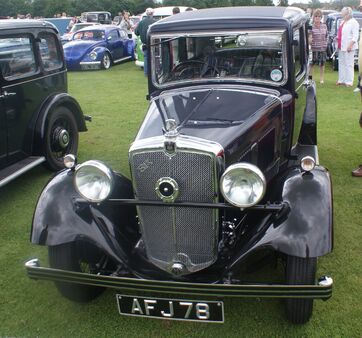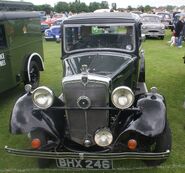
Morris Ten-Six
The Morris Ten was a medium-sized car introduced in 1933 as the company's offering in the important 10 hp sector of the British market. It continued through a series of variants until 1948 when it was replaced by the MO Series Morris Oxford. (The letters 'HP' in the car's name defined originally its fiscal horsepower rather than its bhp.)
Morris Ten-Four[]
The car was powered by a Morris 1292 cc four-cylinder side-valve engine with single SU carburettor. The gearbox was a four-speed unit, and Lockheed hydraulic brakes were fitted.
Body styles at launch in August 1933 were restricted to a saloon and coupé but a tourer joined the range in December followed in 1934 by a two-seater with dickey and a Traveller's Saloon.
The chassis was revised for 1934 and synchromesh appeared on the gearbox. Two tone paint schemes were optional from 1935.
Morris Ten-Six[]
In 1934 a six-cylinder version of the Ten was announced on a longer-wheelbase chassis.
A sporting version, the Ten-Six Special was also made in small numbers with tuned engine and twin SU carburettors. the standard body was an open four-seater, but some chassis were supplied to coachbuilders.
Morris Ten Series II[]
A rationalisation of the Morris range took place in 1935 and the new Ten Series II shared its body and chassis with the Morris Twelve Series II. A three-speed gearbox was fitted at first, but a four-speed re-appeared as an option from 1936 and standard from 1937. Steel disc Easiclene wheels replaced the wire ones at the end of 1936. Two tone paintwork is common.
Morris Ten Series III[]
For 1938 the engine was updated to overhead valve as fitted to the Wolsely 10/40 increasing the power output from 27 to 37.5 bhp. The chromium plated radiator surround was replaced by a painted one and all paint schemes were single, rather than two tone.
Morris Ten Series M[]
A completely new car with unitary construction. The engine, with an output of 37 bhp (28 kW) at 4600 rpm was new and was also fitted to the MG TC sports car in a higher state of tune. The chassis was very conventional for the time, with solid axles front and rear, and the suspension used leaf springs all round. The car had a top speed of around 62 miles per hour (100 km/h).
Only saloon bodies with optional sun roof were made for the civilian market but a range of pick up bodies were fitted during World War II as one of among many similar products by British manufactures collectively known by the nickname "Tillies". The car was also assembled in India as the Hindustan 10 .
Post-war models can be distinguished from those made before 1940 by a cosmetic change to the radiator grill, the later versions being rounder, faired in to the engine side panels and without the Morris badge at the top.






